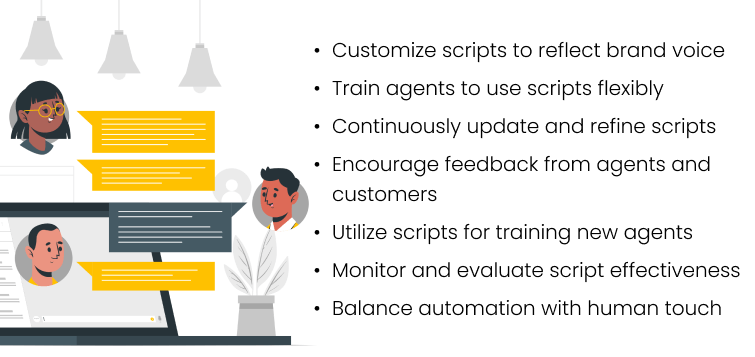Among various tools and strategies, live chat support has emerged as the main communication channel, offering real-time assistance to customer queries and concerns.
Effective live chat scripts play a crucial role in streamlining communication, ensuring consistency, and enhancing customer satisfaction.
This comprehensive guide will explore 45 essential customer service live chat script examples and templates designed to cover a wide range of scenarios. From greeting customers to handling complex support requests, these live chat support examples serve as a valuable resource for customer service reps aiming to deliver proactive customer service.
Additionally, we'll delve into the key elements of successful live chat conversations, share best practices for chat service implementation, and address common questions to help you optimize your chat sessions for better customer feedback and reviews.
So, let’s dive in.
Key Elements of Effective Customer Service Scripts
Before we dive into the specific live chat script examples, it's important to understand the foundational elements that make a chat script effective.

Incorporating these key elements into your live chat scripts can transform your chat service, making it a powerful tool for enhancing customer experience.
Clarity and conciseness
The ability to communicate clearly and succinctly cannot be overstated in the realm of live chat support.
Chat agents must distill complex information into digestible, straightforward answers. This ensures that customers can easily understand the solution without being overwhelmed by technical jargon or verbose explanations.
Live chat scripts should guide customer service live chat examples to be as concise as possible while fully addressing customer queries.
Empathy and personalization
Empathy is the cornerstone of effective customer service. It's crucial for customer support agents not only to understand but also to share the feelings of the customer.
Personalization goes hand in hand with empathy and positive language; addressing the customer by name, acknowledging their issue with genuine concern, and tailoring solutions to their specific situation are all aspects of personalization. This approach transforms standard chat script templates into dynamic tools for building strong customer relationships.
Accuracy
Providing accurate and reliable information is non-negotiable. Misinformation can lead to frustration, mistrust, and decreased customer satisfaction. Ensuring that live chat scripts are regularly updated and fact-checked is essential for maintaining the integrity of your chat service.
Customer service agents should also be trained to verify their canned responses and, if unsure, know the procedures for quickly obtaining the correct information or escalating the chat session to someone who can or finding alternative solutions.
Promptness
Today, customers expect quick responses within a couple of minutes. In fact, studies show that the average wait time for live chat support requests is 2 minutes and 40 seconds. The promptness of replies can significantly impact customer satisfaction and perception of your brand.
Live chat templates often highlight the importance of timely communication, demonstrating that efficiency in handling customer queries or customer requests can lead to positive customer reviews and feedback.
However, promptness should not sacrifice the quality of the response; customer support teams must balance speed with completeness and accuracy.
Adaptability
Each chat session is unique, and as such, live chat scripts need to be adaptable. Chat agents should be able to read the situation, picking up on cues from the customer's tone of language and adjusting their approach accordingly.
This might mean shifting from a formal tone to a more conversational one or vice versa. It also involves recognizing when a live chat support script is not suitable for a particular query and being able to go off-script while remaining professional and helpful.
45 Best Live Chat Examples
Up next, we'll explore 45 examples of live chat customer service and templates that apply these principles across various customer interaction scenarios.
Scripts for welcoming customers
The initial greeting in a live chat session sets the positive tone for the entire interaction. Effective greeting chat conversation scripts make the customer feel welcomed and valued, encouraging open communication and a positive service experience.
1. Simple welcome
- Purpose: Establishes a friendly atmosphere right from the start, inviting customers to share their reason for contacting support.
- Script: "Hi there! Welcome to [Your Company]. How can I make your day better?"
2. Recognizing returning customers
- Purpose: Personalizes the greeting for customers who have interacted with your service before, fostering a sense of belonging and appreciation.
- Script: "Hello [Customer's Name]! Welcome back to [Your Company]. What can we assist you with today?"
3. Proactive offer to help
- Purpose: Demonstrates eagerness to assist, encouraging customers to state their needs or queries without hesitation.
- Script: "Welcome to [Your Company]! Do you need help finding a product, or do you have any questions?"
4. Happy to help
- Purpose: Conveys a positive and enthusiastic attitude towards assisting the customer, enhancing their confidence in the support process.
- Script: "It’s great to see you here! How can we make your experience awesome today?"
Information collection scripts
Effective information-gathering is pivotal for providing precise and helpful responses to customer queries. These scripts help chat agents extract necessary details without overwhelming the customer, ensuring a smooth resolution process.
5. General inquiry
- Purpose: Essential for accurately addressing customer queries, this approach encourages customers to provide detailed descriptions, leading to more effective solutions.
- Script: "Could you provide me with some more details about the issue you're experiencing? This will help me assist you better."
6. Product-specific inquiry
- Purpose: Targets collecting specific details about the product in use, enabling chat agents to offer more accurate, contextually relevant advice and solutions.
- Script: "To ensure I give you the most accurate advice, could you tell me which product version you're using?"
7. Account verification
- Purpose: Prioritizes customer security and ensures that chat agents access the correct account information by verifying the customer's identity through account numbers or registered email addresses.
- Script: "For your security, could you please confirm your account number or registered email address?"
8. Clarifying the problem
- Purpose: Aims to clarify the sequence of events leading to the issue. Understanding what actions the customer took before encountering the problem helps pinpoint the root cause.
- Script: "I understand there's an issue. Could you describe what actions lead up to the problem?"
Solving problems scripts
Troubleshooting scripts are crucial for diagnosing and resolving customer issues. Effective scripts guide chat agents through the problem-solving process, ensuring that customers receive accurate, understandable solutions to their technical problems.
9. Identifying the issue
- Purpose: The initial step in troubleshooting is to identify the customer's issue clearly. This ensures that the agent understands the problem and can begin formulating a solution.
- Script: "Let's make sure we get to the bottom of this. Could you describe the issue you're facing in as much detail as possible?"
10. Proposing a step-by-step solution
- Purpose: Offering a step-by-step solution helps to simplify the process for the customer, making it easier for them to follow along and apply the fix.
- Script: "I suggest we try the following steps to resolve the earlier issue. Let's start with step one, which is [first step]. Please let me know once you've done that, and we can proceed to the next step."
11. Checking for resolution and satisfaction
- Purpose: After proposing a solution, it's important to check if the previous issue has been resolved to the customer's satisfaction, ensuring that the support provided was effective.
- Script: "Have we managed to resolve the issue on your end? Is there anything else I can assist you with today?"
Calls scheduling scripts
These scripts are designed to transition a casual chat conversation into a scheduled sales call, offering a more personalized interaction. Effective scheduling scripts can significantly boost conversion rates by ensuring that potential customers are engaged at the peak of their interest.
12. Initiating the conversation
- Purpose: To gauge the customer's interest in a product or service and introduce the idea of a detailed discussion through a sales call.
- Script: "Based on what you're looking for, I believe [Product/Service] could be a great fit for you. Would you be open to a detailed discussion over a call to explore this further?"
13. Highlighting benefits
- Purpose: To make the proposition more attractive by outlining the benefits of taking the conversation to a more personal level, such as a sales call.
- Script: "A quick call can provide you with a clearer understanding and personalized solutions tailored to your needs. When would be a good time for you?"
14. Confirming the appointment
- Purpose: To confirm the sales call appointment, ensuring both parties have agreed upon the time and date, reducing the chances of a no-show.
- Script: "Great, we have scheduled our call for [Date & Time]. You will receive a calendar invite shortly. Is there a specific aspect you'd like us to focus on during our call?"
Upselling and cross-selling scripts
Upselling and cross-selling are strategies used to encourage customers to purchase higher-end products or additional items, respectively. These scripts are designed to enhance the customer's purchase experience by offering value-added suggestions in a helpful and non-intrusive manner.
15. Highlighting product benefits
- Purpose: To inform the customer about the benefits of a higher-tier product or an additional service that complements their current selection, emphasizing the value it adds.
- Script: "Based on your choice, you might also find [Product/Service] beneficial. It has [Feature] that complements what you're looking for by [Benefit]."
16. Personalized recommendations
- Purpose: To offer personalized recommendations based on the customer's purchase history or preferences, making the suggestion feel more tailored and relevant.
- Script: "I noticed you're interested in [Product/Service]. Customers who bought this also loved [Related Product/Service] for its [Feature]. It seems like a perfect match for your needs!"
17. Exclusive offer mention
- Purpose: To create a sense of urgency and exclusivity by mentioning a special offer or discount available for the upsell or cross-sell item.
- Script: "Just for today, we're offering a special bundle deal if you add [Product/Service] to your purchase. It’s a great opportunity to enhance your experience at a lower price."
18. Demonstrating cost-effectiveness
- Purpose: To show the customer how purchasing a bundle or a higher-end product now can be more cost-effective in the long run.
- Script: "By upgrading to [Higher-tier Product/Service], you actually save [Amount] in the long term. It’s a smart investment considering the additional features you get."
Boosting sales scripts
Effective promotion of sales through live chat involves carefully scripted messages that attract the customer's interest in current deals, discounts, or new offerings. These scripts should entice the customer to take action, whether it's exploring a new product line or taking advantage of a limited-time offer.
19. Highlighting limited-time offers
- Purpose: To create a sense of urgency around a sale or promotion, motivating the customer to act quickly to not miss out on special deals.
- Script: "Did you know we're running a special promotion only available until [End Date]? It includes [Details of the Offer], and I thought you might not want to miss it!"
20. Sharing exclusive discounts
- Purpose: To make the customer feel special and valued by offering them exclusive discounts and coupon codes, enhancing their loyalty, and encouraging purchases.
- Script: "As a thank you for being such a loyal customer, we'd like to offer you an exclusive [Percentage]% discount on your next purchase. Let me know if you're interested, and I'll apply it to your account."
21. Recommending bundles
- Purpose: To suggest bundled products or services at a discounted rate, providing the customer with added value while increasing the order size.
- Script: "We have a fantastic bundle deal currently that includes [Products/Services] at a reduced price. It's a great way to get all you need while saving money!"
Proactive customer engagement scripts
Proactive outreach scripts are designed to initiate a conversation with website visitors, offering help or advice before they ask. This approach demonstrates attentiveness and a willingness to assist, potentially increasing engagement and sales.
22. Engaging first-time visitors
- Purpose: A live chat script for a website welcomes first-time visitors and offers them guidance, making their initial experience positive and memorable.
- Script: "Welcome to [Your Company]! If you have any questions or need recommendations, feel free to ask. I'm here to help!"
23. Assisting with decision-making
- Purpose: To assist visitors who seem indecisive, offering them information or advice that can help them make a decision.
- Script: "I see you’ve been comparing [Product A] and [Product B]. Can I provide you with more details or help you decide which one might be better suited to your needs?"
24. Addressing cart abandonment
- Purpose: To reach out to visitors who have added items to their cart but haven’t completed the purchase, offering assistance or answering any last-minute questions.
- Script: "I noticed you have items in your cart. Is there anything I can help with before you complete your purchase?"
25. Encouraging engagement with offers
- Purpose: This proactive message engages visitors by highlighting current offers or promotions that may interest them, encouraging them to explore further or take advantage of the deals.
- Script: "Don’t miss out on our ongoing sale with up to 50% off on select items! Can I help you find something or provide more information on the offers?"
Answering FAQ scripts
FAQ Scripts are pre-prepared responses to customers' most commonly asked questions. They help deliver quick and consistent answers, improve efficiency, and ensure customer satisfaction by addressing their queries promptly.
26. Product availability
- Purpose: To inform customers about product availability and offer alternatives or notifications for out-of-stock items.
- Script: "The [Product Name] is currently out of stock, but we expect it to be available again by [Date]. Would you like to be notified when it's back in stock?"
27. Shipping information
- Purpose: To provide clear and concise information regarding shipping options, times, and costs.
- Script: "We offer several shipping options: standard, which takes 3-5 business days, and express, which will get your items to you in 1-2 business days. Shipping costs vary based on your location and the size of your order."
28. Return policy
- Purpose: To clarify the return policy, making it easier for customers to understand their options if they're not satisfied with a purchase.
- Script: "Our return policy allows you to return products within 30 days of receiving them, provided they are in original condition. Would you like assistance with processing a return?"
Transferring conversation scripts
When an inquiry or issue exceeds the scope of the initial chat agent's expertise or department, transferring the conversation seamlessly is crucial. These scripts help maintain a positive and consistent customer experience by ensuring the transition is handled with care and clear communication to the correct department.
29. Initiating a transfer
- Purpose: To inform the customer about the need to transfer their chat to another agent or relevant department that is more suited to address their specific needs or concerns.
- Script: "To ensure you receive the best possible assistance with your request, I’ll be transferring you to our [Specific Department] specialist. Please hold for a moment while I make the connection."
30. Explaining the reason for the transfer
- Purpose: To provide a clear explanation as to why transferring the chat is necessary, ensuring the customer understands that this step is in their best interest.
- Script: "Your query requires specialized knowledge about [Topic/Issue], so I'm connecting you with our expert in that area to ensure you get accurate and comprehensive support."
31. Confirming the transfer
- Purpose: To ensure the customer is ready for the transfer and feels reassured that their issue will be addressed promptly by the next agent.
- Script: "I’m ready to transfer you to our [Department/Agent] now. They are well-equipped to handle your [Issue/Query]. Can I proceed with the transfer?"
After-hours scripts
Customers may attempt to initiate a chat session outside of your business's operating hours. Preparing scripts for these common customer service situations helps manage expectations and provides guidance on when and how their concerns can be addressed.
32. Automated after-hours message
- Purpose: To immediately inform customers that they've contacted you outside of your regular chat hours, but their inquiry is still important.
- Script: "Thank you for reaching out. We're currently offline. Our chat hours are [Hours of Operation]. Please leave your message, and we'll get back to you as soon as we're back."
33. Offering alternative contact methods
- Purpose: To provide customers with alternative ways to get the help they need when live chat isn't available.
- Script: "We're sorry we missed you! For immediate assistance, please check our FAQ page or email us at [Email Address], and we'll respond during our next business hours."
34. Encouraging email communication
- Purpose: To direct customers to use email as an alternative way to submit their queries or issues, ensuring they know their options for getting assistance.
- Script: "Our team is currently away, but we'd love to help you. Please send us an email at [Email Address] with your question or issue, and we'll address it first thing when we're back!"
35. Leaving a contact form
- Purpose: To encourage customers to leave their contact information so that a representative can reach out to them as soon as possible.
- Script: "We're sorry to miss you. Please leave your name, email, and a brief message, and one of our team members will reach out to you promptly during our business hours."
Managing unhappy/angry customers scripts
Unhappy customers can be a turning point for customer service. Handling these situations with care, understanding, and effective problem-solving can turn a potentially negative review into a loyal customer relationship.
35. Acknowledging the issue
- Purpose: To show the customer that their issue is understood and taken seriously, which is the first step in resolving the situation.
- Script: "I understand how frustrating this situation could be for you, and I’m truly sorry for any inconvenience it has caused. Let’s work together to find a solution."
37. Asking for specific details
- Purpose: To gather more information about the issue, ensuring that the solution provided addresses the customer’s concerns accurately.
- Script: "Could you please provide more details about the problem? This will help us understand what went wrong and how we can avoid similar issues in the future."
38. Providing a clear solution
- Purpose: To offer a specific, actionable solution to the customer’s problem, showing a proactive approach to resolving their issue.
- Script: "Here’s what we’re going to do to fix this for you [explain the solution]. Does this approach work for you?"
39. Offering a follow-up
- Purpose: To reassure the customer that their issue is being handled with priority and to maintain trust by ensuring consistent communication.
- Script: "I want to make sure this is fully resolved for you. I’ll follow up with you [specific time frame] to confirm everything has been addressed to your satisfaction. Is there anything else I can assist you with in the meantime?"
Requesting feedback scripts
After a customer interaction, it's beneficial to seek feedback. This not only shows that you value the customer's opinion but also provides actionable insights to enhance service quality.
40. Post-resolution feedback request
- Purpose: To gather feedback following a resolved query or issue, ensuring the customer is satisfied with the service and identifying areas for improvement.
- Script: "We're glad we could resolve your issue today. Could you spare a moment to share your feedback on how we handled your request? Your input is invaluable to us."
41. Product/Service feedback inquiry
- Purpose: To obtain customer feedback on a specific product or service, offering insights into customer satisfaction and areas for product enhancement.
- Script: "We hope you're enjoying [Product/Service]. Would you be willing to share your thoughts on it? We're always looking to improve our offerings."
42. Feedback on customer/service interaction
- Purpose: To evaluate the effectiveness and satisfaction of a customer service interaction, aiming to improve communication and support strategies continuously.
- Script: "We strive to offer the best customer service possible. Could you please share how your recent interaction with our team was and any suggestions you have for us?"
Ending conversation scripts
Closing scripts are used to conclude a chat session, ensuring that all customer queries have been satisfactorily resolved and offering further assistance if needed. These scripts are key to maintaining a positive relationship with the customer even as the conversation ends.
43. Confirming resolution satisfaction
- Purpose: To ensure the customer is satisfied with the resolution and the conversation can be concluded positively.
- Script: "Before we end our chat, I want to make sure we’ve addressed everything you needed today. Is there anything else I can help you with?"
44. Thanking the customer
- Purpose: To express gratitude towards the customer for their time and for choosing your service, reinforcing a positive relationship.
- Script: "Thank you for reaching out to us today. We appreciate the opportunity to assist you. Please don’t hesitate to contact us again in the future. Have a great day!"
45. Offering further assistance
- Purpose: To let customers know that help is always available, encouraging them to return if they have more questions or issues.
- Script: "If you have any more questions or need assistance in the future, feel free to contact us anytime. We’re here to help!"
Best Practices for Implementing Live Chat Scripts

Customize scripts to reflect brand voice
Ensure scripts align with your brand’s tone. This customization makes chat interactions feel more authentic and tailored to your brand's unique identity.
Train agents to use scripts flexibly
Agents should be able to adapt live chat response examples to fit the conversation's context, making interactions feel natural and directly relevant to each customer's situation.
Continuously update and refine scripts
Keep scripts current with product updates, service changes, and customer feedback. Regular revisions ensure responses remain accurate and effective.
Encourage feedback from agents and customers
Valuable insights from those interacting with customers and from customers themselves are crucial for refining scripts to better meet customer expectations and resolve issues efficiently.
Utilize scripts for training new agents
Scripts provide a foundation for new agents, offering examples of how to handle various customer interactions and instill confidence in their response strategies.
Monitor and evaluate script effectiveness
Assess scripts' performance using resolution times, customer satisfaction scores, and other relevant metrics to ensure they fulfill their intended purpose.
Balance automation with human touch
While scripts can enhance efficiency, personalizing interactions is crucial. Ensure customers feel they are engaging with someone who genuinely understands and cares about their needs, not just an automated system.
Final Words
Incorporating effective live chat scripts into your customer service strategy is more than just expediting conversations with customers. It's about enhancing the quality of every interaction, ensuring consistency across all customer touchpoints, and, ultimately, building stronger relationships with your customers.
By utilizing the 45 best live chat examples and templates provided, along with adhering to the best practices for implementation, you can elevate your customer service to new heights, fostering an environment of trust and satisfaction.
Remember, the goal is not to rely on scripts so heavily that conversations become robotic. Instead, use them as a foundation upon which your chat agents can build personalized, empathetic, and engaging interactions.
As your business grows and evolves, so too should your scripts, continuously adapting to meet the changing needs and expectations of your customers.
FAQ
What are live chat scripts?
Live chat scripts are pre-written responses or conversation templates that customer service agents use during live chat sessions. They help ensure consistent, accurate, and efficient customer support, covering various scenarios from greetings and information gathering to problem-solving and closing conversations.
Why should you use live chat?
Live chat offers real-time support, significantly reducing wait times and improving customer satisfaction. It provides an immediate communication channel for resolving queries, offering advice, and assisting with sales, which can enhance the overall customer experience and potentially increase conversion rates.
What are the benefits of live chat scripts?
The benefits of live chat conversation examples extend across various dimensions of customer service. They ensure consistency and accuracy in responses, which is crucial for maintaining a high standard of support across all customer interactions.
By having a set of predefined responses, agents can quickly address common queries, significantly saving time and increasing efficiency. This is not only beneficial for the customers, who receive faster replies, but also for the agents, who can manage their workload more effectively.
Additionally, live chat scripts serve as valuable training materials for new agents, offering them concrete chat response examples of how to handle different types of interactions.









